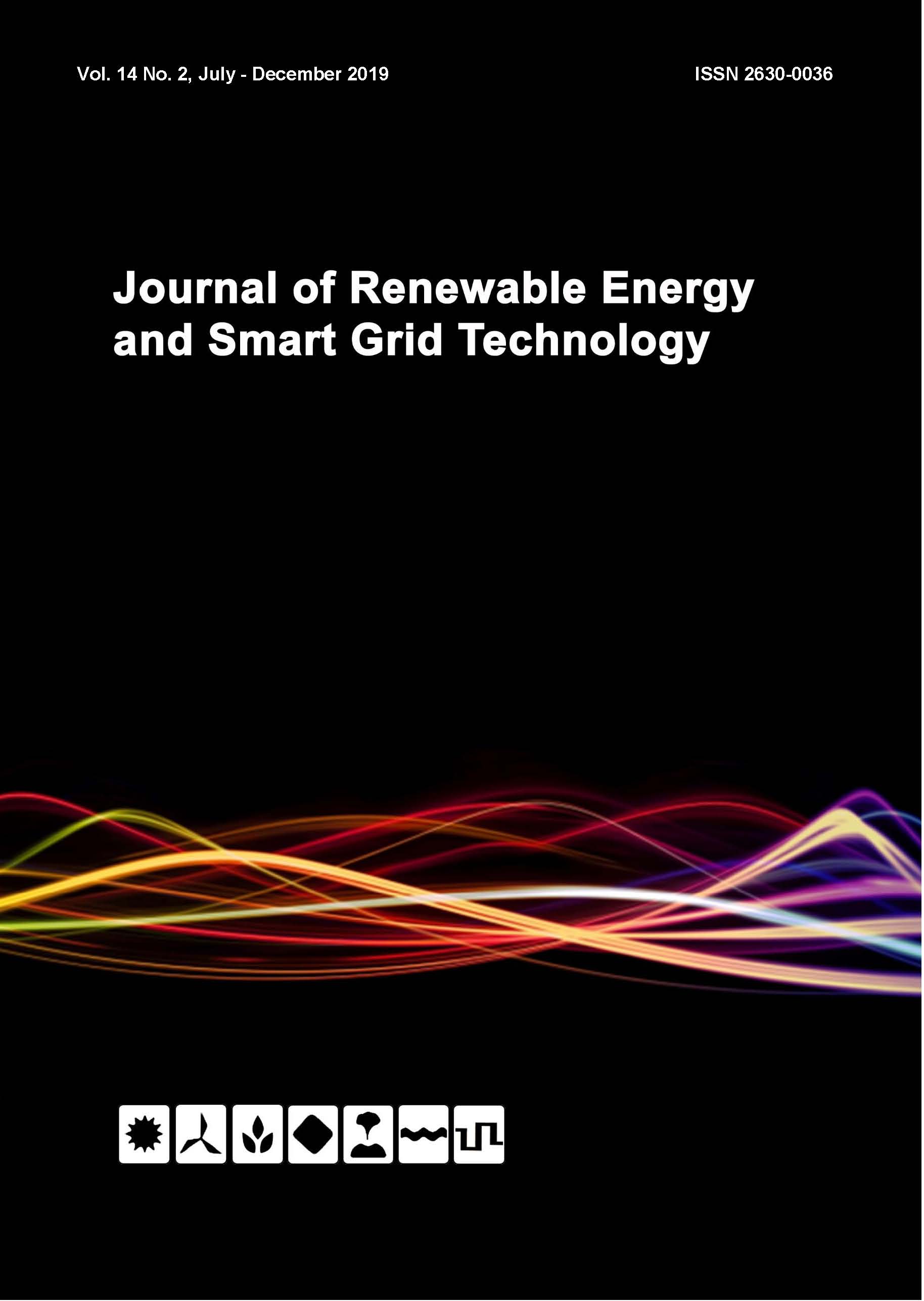Review of the lightning electromagnetic impulse protection measure for smart home and building in smart grid system in Thailand
Keywords:
Smart home, Smart building, Lightning electromagnetic impulse (LEMP), Electromagnetic compatibility (EMC), Power line communication (PLC), Home area network (HAN), Home energy management system (HEMS), Smart GridAbstract
A failure of a smart grid system can cause huge economic losses. particularly for large systems installed to power smart cities. How can interference from hackers using new techniques such as the superpower electromagnetic pulse, or from natural phenomena such as lightning strikes which intensity increases every year be prevented?, the More than 200 strokes per 1 square-kilometer per year of cloud to ground lightning (CG) had been recorded in some area of Thailand and this is projected to increase since extreme weather events, such more frequent very strong thunderstorms, are also increasing .
In depth reviews show that lightning electromagnetic impulse protection measure can be very important for ensuring safety of a smart grid network. The methodologies for the design and installation of smart homes and buildings must conformed with the standards of h EMC/EMI in order for systems to withstand the interferences. As such, the best approach for the protection of the systems against electromagnetic field from both wave propagation and inductance through various conductors is the LEMP protection measure. This consists of the defining the lightning protection zone (LPZ) and lightning protection level (LPL) and the design and installation of the earthing system, lightning protection system (LPS), shielding, equipotential bonding, cable path and the combination of SPDs. This paper has shown the appropriate concept architecture of LEMP protection measure for smart home and building in smart grid system in Thailand.
References
[2] Tibor Horvath (2014, September). Lightning Electromagnetic Impulse, Research Studies Press Limited. [Online]. Available: https://doi.org/10.1002/ 978040030875.ch19
[3] Albert R. Martin (2010). Safety Issues and Damage to Equipment with both Smart Grid and home network connections, IEEE Symposium on Product Compliance Engineering (ISPCE2010), IEEE Catalog Number CFP10PCD-PRT.
[4] Gurevich., V. (2011). Smart Grid: New Prospects or New Problems?(Part 2), Perspective Research of Modeling Processes and Systems, Electrical Systems and Control Systems, 3/2011, PP. 73-80.
[5] Ronnie, D., Caytiles., & Sunguk, L. (2015). A Survey of Recent Power Line Communica-tion Technologies for Smart Micro Grid, International Journal of Software Engineering and Its Applications, 9., 12, pp. 251-258.
[6] Aderemi, A., Atayero, A.A., Alatishe., & Yury, A. Ivanov, Members, IAENG (2012). Power Line Communication Technologies: Modeling and Simulation of PRIME Physical Layer, Proceedings of the World Congress on Engineering and Computer Science 2012 (WCECS 2012), 2.
[7] Stefano, G., Senior Member IEEE, Anna S., Fellow IEEE, & Zhifang W., Member IEEE. (2011). The role of power line communications in the Smart Grid, Proceedings of the IEEE, 99., 6,
[8] Muhammad Salman Yousuf and Mustafa El-Shafei, (2008). Power Line Communication: An Overview – Part 1, King Fahd University of Petroleum and Minerals, 978-1-4244-1841-1/08/$25.00 ©2008 IEEE, pp. 218-222.
[9] Larry, Y., Jose, A., Kaywan, A., Lorenzo, G., Srinivas, K., Hidayat, L., Pascal, P., Raffaele, R., Daniel M. S., & Andreas S. (2012). An Overview of the HomePlug AV2 Technology. Hindawi Publishing Corporation Journal of Electrical and Computer Engineering. [Online]. 892628, Available: http://dx.doi.org/10.1155/2013/892628.
[10] Md. M.R., Choong, S.H., & Sungwon, L., Kyung Hee University. Jaejo L. Korea Electrotechnology Research Institute, Md. Abdur Razzaque and Jin Hyuk Kim, Kyung Hee University (2011). Medium Access Control for Power Line Communications: An Overview of the IEEE 1901 and ITU-T G.hn Standards, IEEE Communications Magazine, pp. 183-191.
[11] Bush, Stephen F. (2014). Communication and Networking: The Enabler, Smart Grid Communication-Enabled Intelligence for the Electric Power Grid, 1st ed., USA: IEEE Press, John Wiley and Sons, pp. 185-354.
[12] Hans Dieter Betz, Ulrich Schumann and Pierre Laroche (2009). Present Understanding of the Lightning Return Stroke, Lightning: Principle, Instruments and Applications, 1st ed., Springer, pp. 1-21.
[13] Teng-amnuay, Y. (2015). Energy Management System HEMS, BEMS, FEMS, CEMS and Renewable Energy, National Research Council of Thailand, [Online]. Available: http://www.pointthai.net
[14] Tadashi Matsuzaki and Shinji Tanabe (2005). Perspective on Power Line Communication. Mitsubishi Electric Advance, 109., pp. 2-4.
[15] Kenneth C. Budka, Jayant G. Deshpande and Marina Thottan (2014). Introduction to Smart Grid, Communication Networks for Smart Grids, 1st ed., London: Springer, pp. 1-21.
[16] Ekram Hossain, Zhu Han and H. Vincent Poor (2012). Communication Architectures and Models for Smart Grid, Smart Grid Communications and Networking, 1st ed., Cambridge, United Kingdom: Cambridge University Press, pp. 1-103.
[17] IEC 62305-1 (2012). Protection against lightning – Part 1: General principles.
[18] IEC 62305-2 (2012). Protection against lightning – Part 2: Risk management.
[19] IEC 62305-3 (2012). Protection against lightning – Part 3: Physical damage to structures and life hazard.
[20] IEC 62305-4 (2012). Protection against lightning – Part 4: Electrical and electronic system within structures.
[21] IEC/TR 61000-5-6 (2002). Electromagnetic compatibility (EMC) – Part 5-6: Installation and mitigation guidelines – Mitigation of external EM influences, First edition 2002-06.
[22] MIL-STD-464B (2010). Electromagnetic environmental effects requirement for system.
Downloads
Published
How to Cite
Issue
Section
License
All copyrights of the above manuscript, including rights to publish in any media, are transferred to the SGtech.
The authors retain the following rights;
1. All proprietary rights other than copyright.
2. Re-use of all or part of the above manuscript in their work.
3. Reproduction of the above manuscript for author’s personal use or for company/institution use provided that
(a) prior permission of SGtech is obtained,
(b) the source and SGtech copyright notice are indicated, and
(c) the copies are not offered for sale.








